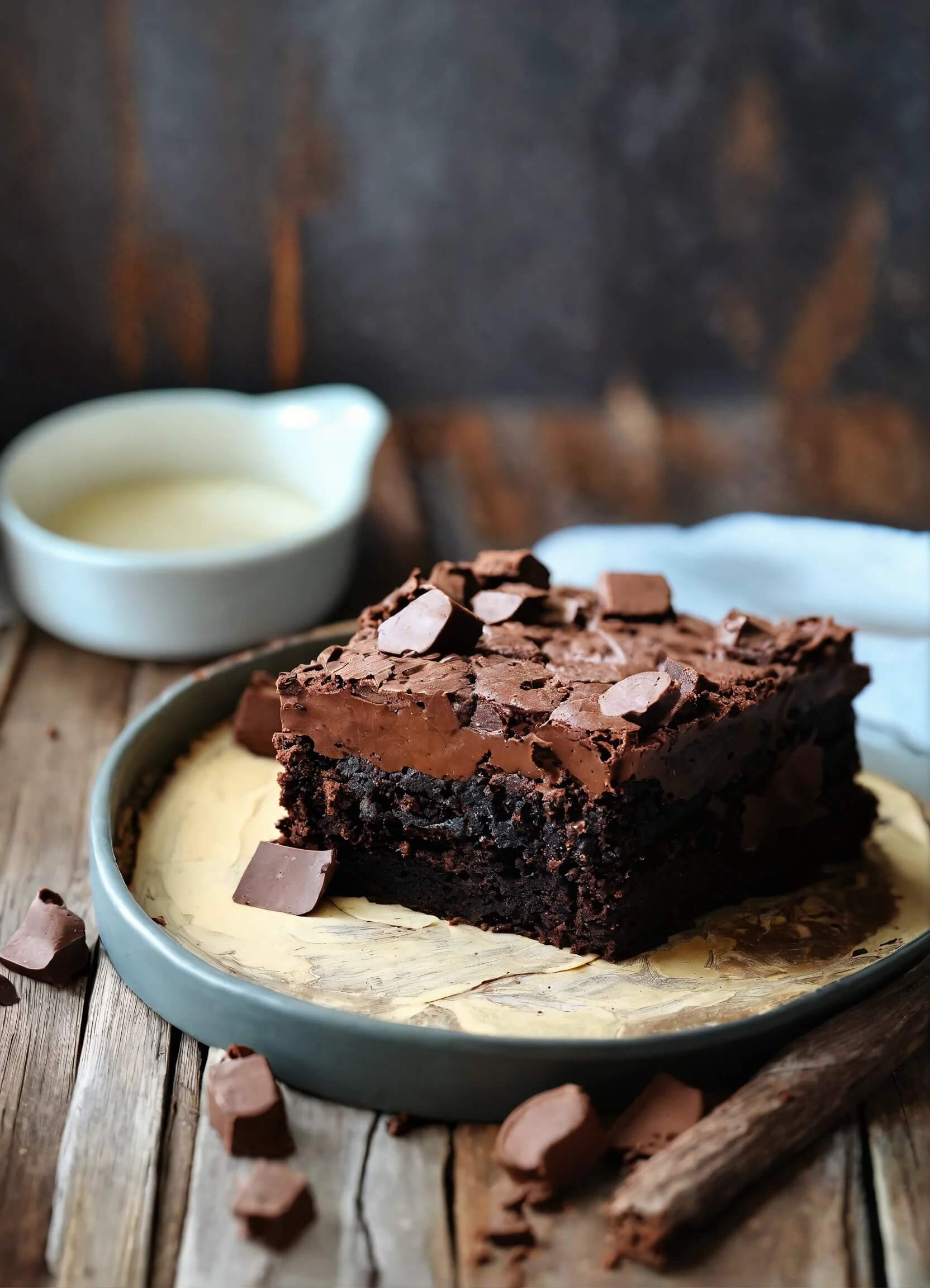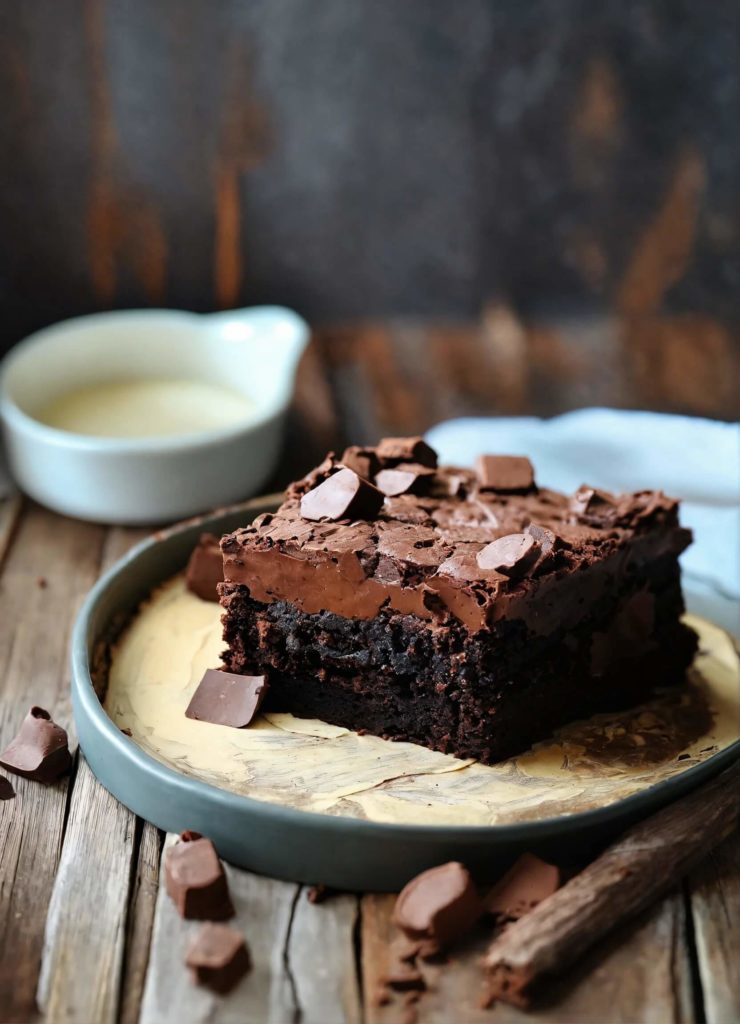Types of Brownie Cakes
The world of brownie cakes is diverse and flavorful, offering something for every palate. Here are some popular types:
Classic Chocolate Brownie Cake
The Classic Chocolate Brownie Cake is a timeless favorite. It’s where the simplicity of a brownie meets the elegance of a cake. This type typically features a rich, chocolatey base, often made with high-quality cocoa powder or melted chocolate. The texture strikes a perfect balance between a cake’s fluffiness and a brownie’s density. It’s commonly topped with chocolate ganache or a dusting of powdered sugar, making it a hit for its classic appeal and decadent taste. This cake is a go-to for those who cherish the traditional chocolate flavor in its purest form.
Fudge Brownie Cake
For those who prefer a denser, more intense chocolate experience, the Fudge Brownie Cake is an ideal choice. This variation is all about the fudgy texture, achieved by reducing the flour and increasing the amount of chocolate and butter. The result is a cake that’s incredibly moist and rich, almost crossing into the territory of a chocolate truffle. Some recipes also incorporate chunks of chocolate or a layer of chocolate fudge, enhancing the gooeyness. This type is a dream come true for hardcore chocolate enthusiasts.
Vegan and Gluten-Free Options
In today’s inclusive culinary world, brownie cakes are not just limited to traditional recipes. Vegan and gluten-free options have gained popularity, catering to diverse dietary needs and preferences. Vegan brownie cakes substitute eggs and dairy with ingredients like flaxseeds, almond milk, and vegan butter. Gluten-free versions use alternative flours such as almond or coconut flour, ensuring that the cake is safe for those with gluten sensitivities. These adaptations have opened up the joy of brownie cakes to a broader audience, proving that indulgence can be both inclusive and delicious. For more innovative baking ideas, check out I Am Baker.
Ingredients and Baking Essentials
Creating the perfect brownie cake requires a blend of key ingredients and the right baking tools. Here’s what you need to know:
Key Ingredients for a Perfect Brownie Cake
- Chocolate: The soul of any brownie cake, chocolate can be used in various forms – cocoa powder for a deep, rich flavor, or melted chocolate for a fudgy texture.
- Butter: It adds moisture and richness, giving the cake a tender crumb.
- Sugar: Typically, a mix of brown and white sugar is used. Brown sugar contributes to the moistness, while white sugar provides sweetness and a crisp top.
- Eggs: They act as a binding agent and give the cake structure. For a fudgier texture, some recipes call for an extra egg yolk.
- Flour: All-purpose flour is commonly used, but for a denser cake, some bakers reduce the quantity. Gluten-free flours are also an option for those with dietary restrictions.
- Leavening Agents: A small amount of baking powder or baking soda helps the cake rise.
- Vanilla Extract: It enhances the chocolate flavor and adds depth.
- Salt: A pinch of salt balances the sweetness and intensifies the overall flavor.
Essential Baking Tools and Equipment
- Mixing Bowls: You’ll need at least two – one for dry ingredients and one for wet.
- Whisk/Spatula: Essential for mixing the batter to the right consistency.
- Measuring Cups and Spoons: Precision is key in baking, making these tools crucial.
- Baking Pan: A square or rectangular pan is standard for brownie cakes. The size of the pan can affect the thickness and baking time.
- Parchment Paper: Lining your pan with parchment paper ensures easy removal of the cake.
- Oven Thermometer: Since oven temperatures can vary, an oven thermometer is vital for accuracy.
- Cooling Rack: Allows the cake to cool evenly without getting soggy.
With these ingredients and tools, you’re well-equipped to bake a brownie cake that’s sure to impress. Whether you’re a seasoned baker or a novice, understanding these essentials is the first step to baking success. For a comparative look at different brownie recipes, visit The Pancake Princess.
Step-by-Step Baking Guide
Baking a brownie cake is an enjoyable process that combines the art of precision with the joy of creativity. Here’s a step-by-step guide to help you bake the perfect brownie cake.
Preparing the Batter
- Start with Room Temperature Ingredients: Ensure that ingredients like butter and eggs are at room temperature for a smoother batter.
- Mix Dry and Wet Ingredients Separately: Whisk together all dry ingredients (flour, cocoa powder, salt, and leavening agents) in one bowl. In another bowl, cream the butter and sugars until fluffy, then add eggs and vanilla extract.
- Combine Dry and Wet Mixtures: Gradually mix the dry ingredients into the wet mixture. Avoid overmixing; stop as soon as you see no more flour streaks.
- Fold in Chocolate: If using chocolate chunks or chips, fold them in at the end for an even distribution.
- Prepare the Baking Pan: Grease your pan and line it with parchment paper for easy removal of the cake after baking.
Baking Tips and Techniques
- Preheat Your Oven: Always start with a preheated oven for even baking.
- Pour and Smooth the Batter: Pour the batter into the prepared pan and smooth the top with a spatula.
- Bake at the Right Temperature: Bake the cake at the temperature specified in your recipe. This is usually between 350°F to 375°F (175°C to 190°C).
- Use a Toothpick to Check Doneness: Insert a toothpick into the center of the cake. If it comes out with a few moist crumbs, the cake is done.
- Avoid Overbaking: Overbaking can dry out a brownie cake. Keep an eye on the baking time and check the cake towards the end of the recommended baking period.
Cooling and Frosting
- Cool in the Pan: Let the cake cool in the pan for about 10-15 minutes. This helps it set and reduces the risk of breaking.
- Transfer to a Cooling Rack: Carefully lift the cake out of the pan using the parchment paper and place it on a cooling rack to cool completely.
- Frosting the Cake: Once cooled, you can frost the cake. For a classic brownie cake, a rich chocolate ganache or a buttercream frosting works well. Spread the frosting evenly over the cake.
- Decorate as Desired: Add toppings like sprinkles, nuts, or chocolate shavings for an extra touch of elegance.
By following these steps, you can bake a brownie cake that’s not only delicious but also a feast for the eyes. Remember, baking is as much about the journey as it is about the end result, so enjoy the process and have fun!
Decorating and Serving Ideas for Brownie Cake
A brownie cake, with its rich flavor and versatile texture, offers a canvas for creative decoration and diverse serving options. Here are some ideas to elevate your brownie cake into a stunning dessert.
Creative Decoration Tips
- Ganache and Glazes: A glossy chocolate ganache or a simple glaze can add both flavor and visual appeal. Pour it over the cake and let it drip down the sides for an elegant finish.
- Dusting and Toppings: A light dusting of powdered sugar or cocoa powder can give a sophisticated look. Sprinkles, crushed nuts, or chocolate shavings also make great toppings.
- Piped Frosting: Use a piping bag with a star nozzle to add buttercream or cream cheese frosting swirls. This not only looks beautiful but adds a creamy texture.
- Edible Flowers and Fruit: For a fresh, vibrant look, decorate with edible flowers or fresh fruit like strawberries or raspberries.
- Themed Decorations: Tailor your decorations to the occasion – colorful sprinkles for a birthday, heart-shaped chocolates for Valentine’s Day, or festive ornaments for Christmas.
Serving Suggestions
- Classic Cut: Serve your brownie cake in traditional square or rectangular slices. It’s a classic way to enjoy this dessert and works well for casual gatherings.
- A La Mode: Elevate your brownie cake by serving it warm with a scoop of vanilla ice cream. The contrast of warm cake and cold ice cream is irresistible.
- With Coffee or Tea: Brownie cake pairs wonderfully with coffee or tea, making it a great choice for brunch or an afternoon treat.
- Dessert Parfait: Layer crumbled brownie cake with whipped cream and fresh berries in a glass for an elegant parfait.
- Mini Bites: Cut the cake into small cubes and serve them as bite-sized treats at parties or as a sweet snack.
Whether you’re aiming for simple elegance or festive flair, these decorating and serving ideas can help you present your brownie cake in the best possible way, making it not just a dessert, but a centerpiece of your culinary presentation. Discover more about dessert pairings.
Storing and Preserving Brownie Cakes
Proper storage of a brownie cake is essential to maintain its flavor and texture. Whether you’re looking to keep it fresh for a few days or preserve it for longer, here are some effective storage and preservation tips.
Short-term Storage
- Room Temperature: For short-term storage, keep the brownie cake in an airtight container at room temperature. It will stay fresh for about 3 to 4 days.
- Refrigeration: If your kitchen is particularly warm or if the cake is frosted with a cream-based topping, refrigerate it. Place it in an airtight container to prevent it from absorbing other food odors.
Long-term Storage
- Freezing: For long-term storage, freezing is the best option. Wrap the cake tightly in plastic wrap and then in aluminum foil to prevent freezer burn. You can store it for up to 3 months.
- Slicing Before Freezing: Consider slicing the cake before freezing. This way, you can thaw only as many pieces as you need at a time.
Freezing and Reheating Tips
- Thawing: Thaw the frozen brownie cake by leaving it at room temperature for several hours or overnight in the refrigerator.
- Reheating: If you prefer your brownie cake warm, reheat it in the microwave for a few seconds. Be careful not to overheat, as this can dry out the cake.
Following these storage and preservation tips ensures you enjoy your brownie cake at its best, whether freshly baked or savored over time.
Health and Nutrition
While brownie cakes are a delightful treat, being mindful of their health and nutritional aspects is important, especially for those monitoring their diet.
Caloric Content and Nutritional Information
- Rich in Calories: Brownie cakes are typically high in calories. A standard slice can contain anywhere from 200 to 400 calories, depending on the ingredients and serving size.
- Sugar and Fat: They are also rich in sugars and fats, contributing to their calorie density. This includes both saturated and unsaturated fats, coming from ingredients like butter and chocolate.
- Carbohydrates: Being a dessert, brownie cakes are high in carbohydrates, primarily from sugars and flour.
- Proteins and Fibers: Eggs and milk provide modest amounts of protein, and using whole grain flour adds some fiber.
Healthier Ingredient Alternatives
- Reducing Sugar: You can reduce the sugar content by using natural sweeteners like honey or maple syrup, or artificial sweeteners that are lower in calories.
- Using Whole Grains: Substitute all-purpose flour with whole wheat or oat flour to increase the fiber content.
- Healthy Fats: Replace butter with healthier fats like avocado or coconut oil.
- Egg Alternatives: For a lower cholesterol option, use egg substitutes or flaxseed meal mixed with water.
- Dark Chocolate: Opt for dark chocolate with a higher cocoa content for less sugar and more antioxidants.
Incorporating these healthier alternatives can make brownie cakes more suitable for those looking for a guilt-free indulgence. However, it’s important to enjoy them in moderation as part of a balanced diet.
FAQs about Brownie Cake
Q: Can I make brownie cake without eggs?
A: Yes, you can use egg substitutes like applesauce, mashed bananas, or commercial egg replacers for a vegan version.
Q: How do I know when my brownie cake is perfectly baked?
A: Insert a toothpick into the center; if it comes out with a few moist crumbs, it’s done. Avoid overbaking to maintain moisture.
Q: Can brownie cake be made gluten-free?
A: Absolutely! Use gluten-free flour blends available in the market for a gluten-free brownie cake.
For more detailed brownie recipes and baking tips, explore Brown Eyed Baker.
Conclusion for Brownie Cake
In the delightful world of desserts, the *brownie cake* stands out as a versatile and beloved treat. From its rich, chocolatey goodness to its adaptable nature catering to various dietary needs, this dessert is more than just a sweet indulgence; it’s a celebration of flavors and textures. As a seasoned baker or a kitchen novice, you will find joy and satisfaction in the journey of baking and enjoying a brownie cake.
Remember, the key to a perfect brownie cake lies in the quality of ingredients, precision in preparation, and passion in the baking process. You’re well-equipped to create a masterpiece that satisfies the taste buds and brings people together, using the tips and techniques this guide provides.
So, preheat your ovens, gather your ingredients, and embark on the delightful adventure of baking a brownie cake. Whether it’s for a special occasion or a simple treat for yourself, a slice of brownie cake is sure to bring a smile to anyone’s face. Happy baking!



